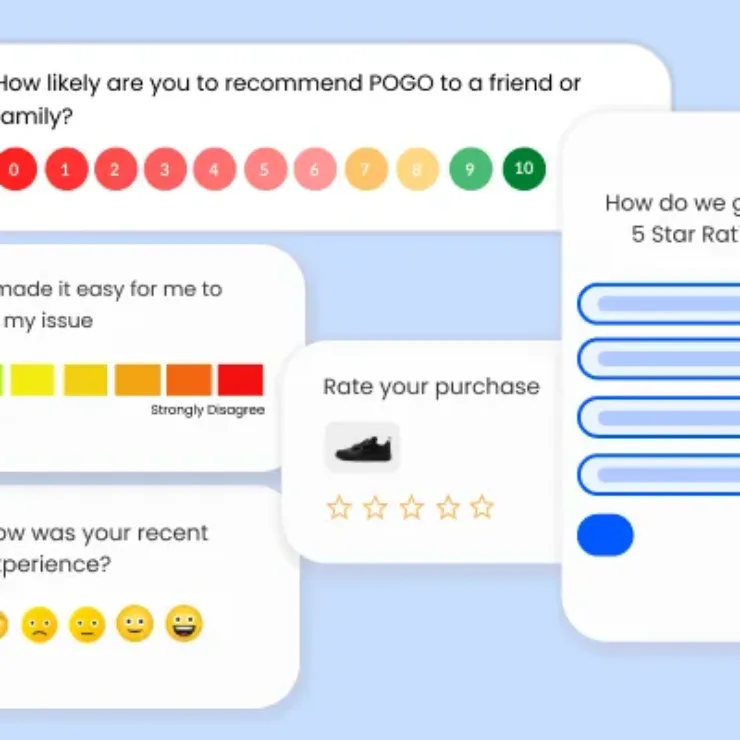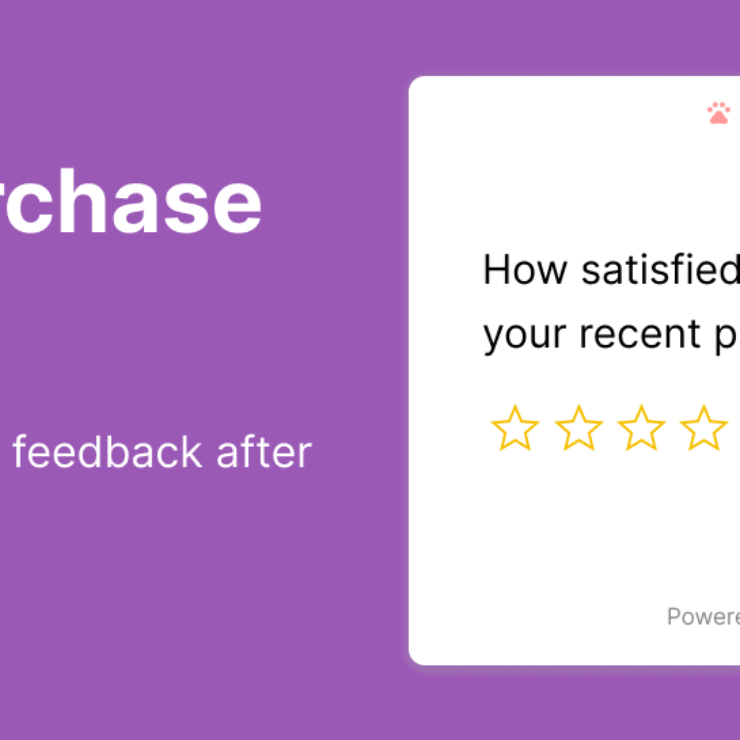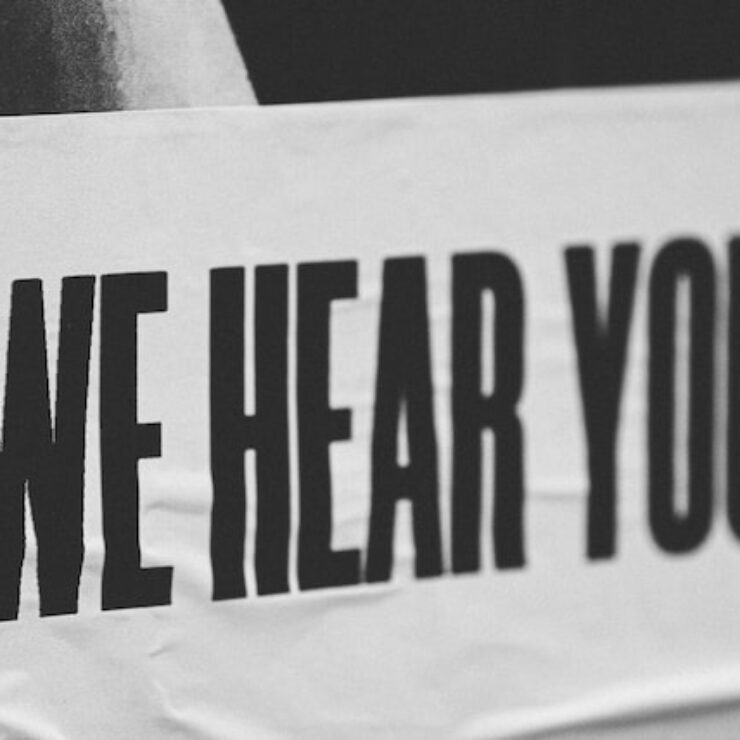Table of Contents
Summary
Want to know what your customers are thinking about your product? What’s working well and the areas of improvement? How happy they are and whether they will recommend your product to others? Or want to have pre-launch feedback on a new product or feature? In the competitive world of software saas, understanding your customer needs is more important than ever. With the right goals and the right set of questions, you can build better products based on customer insights. In this guide, we have picked some of the best product survey questions, when to use them, and the best practices.
TL;DR
- Product Survey is an important tool for the product manager. Product surveys can be done at various stages of the product life cycle. Some of the stages are as follows. During a new product conceptualization, pre-launch, early customer feedback just after launch, continuous product feedback, churned customer feedback, etc.
- It’s important to have well-researched product survey questions for the exercise to be effective. A survey can give you a lot of data, but a set of well-researched product survey questions can help you get the right insights. To create a great product survey, you must start with a clear goal. What stage is your product, which set of users are the right ones for this survey, what do you want to learn from the product survey, and so on.
- Generally, the product survey questions can be categorized under various headers.
Customer Satisfaction or Loyalty questions – These set of customer experience (CX) questions help you judge the satisfaction level of your customers. The key ones here are the NPS and CSAT questions. These questions can also indicate loyalty towards your product.
Product Market Fit Questions – These questions are part of the survey conducted during the early stage of product conceptualization or development. These can serve as early indications of how well your product will be adopted once launched. This can also help understand various go-to-market strategies for your product.
Product Performance Questions – These questions help you understand how well the product performs when used by your customers. For example, the usability, reliability, speed, etc.
Features and Roadmap Questions – These questions help you identify the top features that your customers love and the ones that are missing from your product. Done well, you can get a set of features that can be ordered according to their usefulness to your customers.
Competition Questions – Every SAAS product, no matter how niche it is, can have competition. Understanding what your customers have already tried or considered trying can provide you with competitive insights.Below we have covered the questions under these categories in detail.
- Once you have identified the set of questions, you can consider sending the survey using various methods. Embed the survey in your website or App, send the survey over email, send survey links, etc.
- you can follow some of these best practices to get higher and more meaningful responses. Start with a clear goal. Communicate the purpose of the survey clearly to the respondent. Avoid leading and biased questions. Go for a limited set of questions with easy-to-understand language. You can run the questions past a few of your colleagues to refine them and get feedback on the questions themselves.
Want to create a Product Survey in minutes?
With Affiniv, you can create beautiful surveys and send them instantly via Email or Embed in your website/app.
Why should you conduct product survey?
Before getting into the product survey questions, let’s first see why should product managers run product review surveys.
Every product goes through a life cycle. Some of the stages are – new product conceptualization, early-stage development, beta testing, early customers, new feature development, etc. Product surveys at each of these stages can bring in the voice of customers and can provide you with the right insights to build better products and features.
Let’s look at each of the stages in a little more detail and explore how product surveys can add value at these stages.
Early product conceptualization
Are you building the right product? Who are the target customers? Who are the early adopters? What are they already using? What is the price they are willing to pay? Some of these are very important questions at an early stage. The right set of product survey questions can help answer some of these questions. Along with surveying a larger group, you should also look at personally talking to a small set of customers to get more detailed feedback.
Pre-launch feedback
At this stage, you may have a minimum viable product or MVP. You may also have identified a few customers who are willing to be your early customers. As you start giving the finishing touch to your MVP, you should plan to do a product survey to iron out some of the details in design and functionality. The right product survey questions at this stage can help you understand aspects like usability, UI/UX, robustness of critical functionalities, etc. The success of MVP can depend on this minimum set of functionalities built well! So take some customer feedback at this stage while you give a finishing touch.
Beta Testing Feedback
This is the stage your early customers are using your product. Product survey questions at this stage will focus on the usability, feature set, missing features, workflows, etc. These insights will help you improve your products for your next set of customers. Your product survey questions can also focus on pricing at this stage. These early sets of customers can give you a more accurate idea of pricing based on the problem that your product is solving for them.
Continuous improvement and new feature insights
At this stage, your product is somewhat mature for a particular use case. The product survey questions will help you measure the CX metrics like NPS, CSAT, and CES. And also helps identify the features that are performing well and the ones that need improvement. Done well, you can develop your product roadmap in collaboration with your customers. At this stage, you should conduct product surveys continuously to keep improving your product. Say once every month or every quarter.
Churn prevention insights and post-churn feedback
At every stage of your product lifecycle, some customers may not be happy with your product. Say the initial set of customers are finding your product more complex now. Some enterprise customers need more security and compliance features. The right product survey questions can identify these customers early and help with retention. Also, the customers who have churned can provide you with critical feedback on your product and competitors.
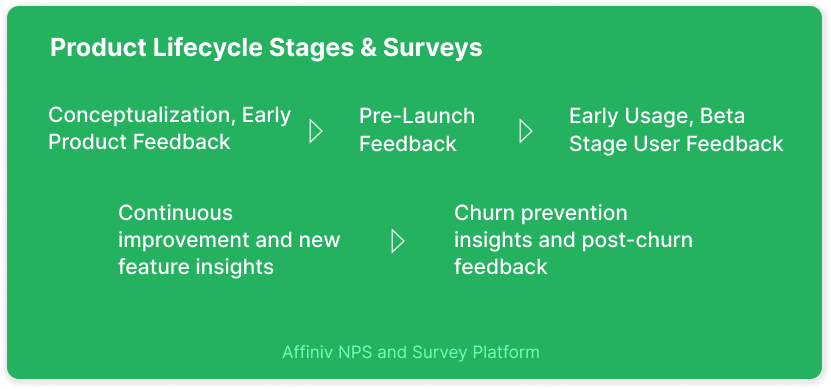
Product Survey Questions
Here is a list of product survey questions applicable at various stages of the product lifecycle.
1. How likely are you recommend our product to a friend or colleague?
This is the classic NPS question and ranks at the top among the most frequently asked customer experience (CX) questions. Invented at Bain & Co., the NPS question is a top measure of customer loyalty. The response is on a scale of 0 – 10, where 0 being “very less likely” and 10 being “highly likely”. Users selecting 0 – 6 are called Detractors, 7 and 8 are Passives, and 9 and 10 are Promoters. The NPS is arrived at by using the formula – (percentage of promoters – percentage of detractors).
NPS is a standard measure of customer loyalty. You can compare and benchmark your NPS against other businesses in your sector and the industry average. You can visit our NPS page to have more details and create a free NPS survey.
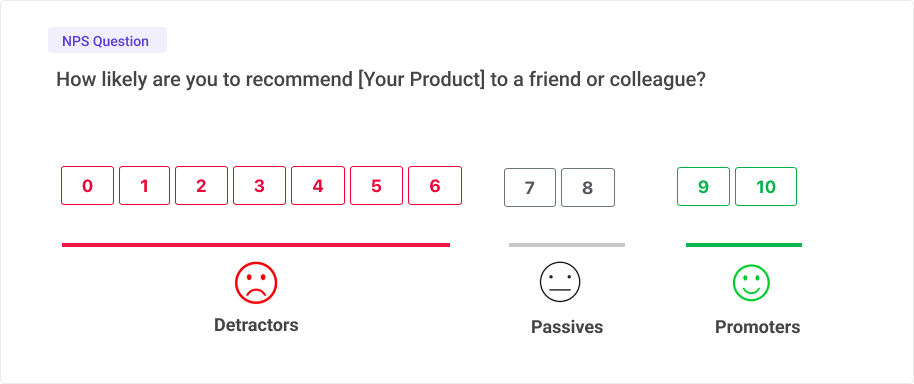
2. How satisfied are you with our product/feature?
This customer satisfaction question aims at measuring one of the key CX metrics – CSAT. The response is a 5-point scale, ranging from 1 – 5. 1 is “Not Satisfied at all” and 5 is “Highly Satisfied”. This CSAT question can be used to measure the satisfaction level at various features or even at the product level. For a deeper analysis of when to use CSAT vs NPS, please refer to this post.
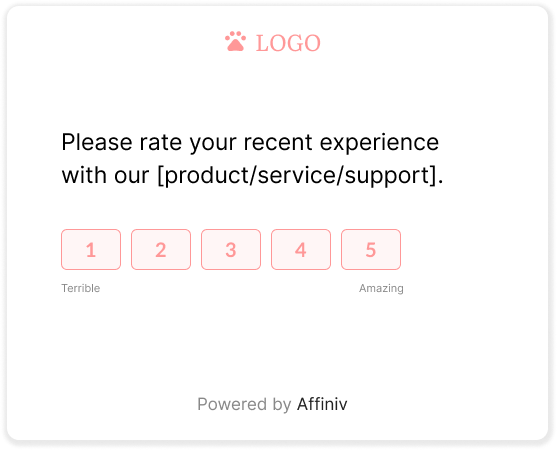
3. How can we improve our product to meet your expectation?
This is a long answer question, only shown to the customers who are unhappy with your product. This group can consist of unsatisfied, detractors, or even passives. Unsatisfied/Unhappy customers are the ones who have chosen 1 or 2 in a CSAT survey. Detractors are the ones who have chosen 0 – 6 in your NPS survey. Passives have chosen 7 or 8 in an NPS survey. This question helps bring out additional insights on what you need to improve in your product for this set of customers.
4. What features do you like the most?
This long answer question is meant for your happy customers or promoters after they choose 9 or 10 in an NPS survey or 4/5 in a CSAT survey. This gives you an understanding of the features that your customers like. There could be several ways of using this response. For example, you can make the highly liked features more visible. So that more of your customers use these features which results in a high degree of customer delight.
5. What are the top 3 features that you want to see in the product?
This is a long answer question, meant to help you create a product roadmap in consultation with your customers. Irrespective of the stage that your product is in, this question can help you identify the key features that are valuable to your customers. You can collate all the responses and prioritize the features to be included in your product roadmap.
6. How much effort does it take to use our product (or a particular feature)?
This is the Customer Effort Score or the CES question. This can be a 5 or 7-point scale question with scores ranging from 1 – 5 or 1 – 7. 1 being “A lot of effort”, and 7 being “Very Easy”. The goal of the CES question is to find out the usability aspect of your product. That is whether your customers find it difficult or easy to use. This question is most commonly used to understand the usability of a particular feature. For example, how easy is it to use our invoicing feature?
7. If you have contacted support recently, please rate the quality of support.
If you are running a product, occasionally your customers will run into issues. Or they may need support to perform certain tasks. This 5-point rating scale will give you insight into how satisfied are your customers with your support team. You can follow this with a long answer question for the customers who are not happy with your support.
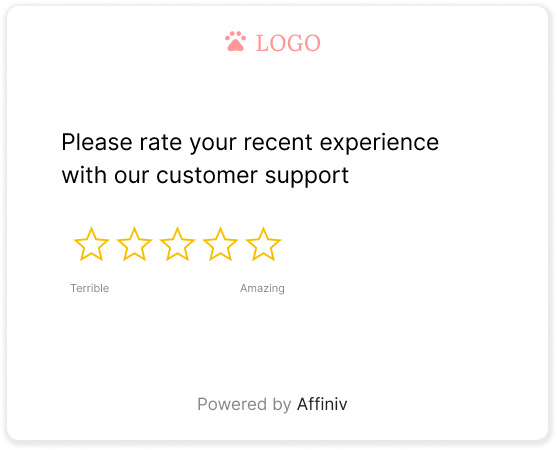
8. How was your experience with our onboarding/implementation.
This is a 5-point scale question. This question is relevant for the customers who went through your onboarding process or the initial implementation process. This is particularly important for the larger ticket saas/software product, where there is a need for initial customization or implementation. Onboarding is often the first touchpoint of a product for a customer. You would want it to be as smooth as possible by removing all friction based on your customer feedback. If a customer rates 3 or below, you should have a follow-up long answer question to collect more detailed feedback from the customer.
9. What products did you use for your <insert your solution here> needs before using our product?
This question can help you understand which of your competitors your customers have tried. You may already know some of your competitors, but some could surprise you. For example, you may be making a product to simplify operations and consider other operations software as your competitors. However many of your customers may be using spreadsheets with custom rules and formulae to manage their operations.
This question can be a multiple choice question, with some of your competitors listed and an “Other” option for the missing ones.
10. Why did you choose our product?
With this question, you are trying to understand why the customer chose your product vs some of your competitors. This insight is very useful as it can help you reach out to similar businesses with similar needs. Perhaps they liked some feature, simplicity, your UI, your sales team, referred by a colleague, and so on. Understanding why they chose you can give you insights that you can highlight in your sales presentation or website.
11. How do you rate the speed and performance of our product compared to the other products that you use?
This can be a 5-point scale, where 1 is “Terrible” and 5 is “Outstanding”. Speed is extremely important for software today. Many products that your customers use in their daily lives raise the bar for speed. So if your customer perceives your software to be slow that can be a major red flag. This question helps you uncover such issues.
12. How often do you use our product?
This question can be a multi-choice question with options such as – Once in 15 days, once a week, multiple times a week, Daily, etc. The frequency is an important indicator of the usefulness of your product. The more times it gets used, the chances are that your product provides the desired benefit to your customers. Also, a highly used product may have a lesser churn risk. But keep in mind that all products and users may not be the same. For example, for a survey and customer success software like Affiniv, users like PMs and Customer Success managers/reps may be using the product daily. However, the users in the top management may look at the dashboards once a week or a few times a month. So depending on the category of user and product, it’s ok to have a lower number here.
13. Rate our product in terms of value for money.
This can be a scale question where 1 – “Not good value for money” and 5 – “Excellent value for money”. This question can help you find out how your customer perceives your product compared to your competitors or the other products they use. For some products, the customers may be using them, even though it’s expensive. Primarily because there are no viable alternatives or there is a large switching cost to move to another product. Or if most of your customers are very satisfied with your pricing, you may be pricing it lower. Having this insight can help you set the price of your product in a more informed manner.
Want to create a Product Survey in Minutes using our template?
With Affiniv, you can create beautiful surveys and send them instantly via Email or Embed in your website/app.
How to share your product survey questions with respondents?
You have created the product survey. And put in place the right questions depending on the stage of your product. Now it’s time to share it with your customers. There are several ways to share your survey. You can use a mix of the following modes to get a higher number of responses. A survey software like Affiniv can help you share the survey over multiple channels easily.
Embed your survey in the product/app
Embedding your survey in the product is the best way for your customers to notice the same. With survey software like Affiniv, you can set the rules to show the survey on specific pages. You can also show it after a certain delay, based on user properties, and more. The biggest pro of embedding the survey in your product or app is that you can show it to your customers right when they are using it. That’s the best time to get their attention. The downside is that they may not give you detailed feedback as they are already busy with a task.

Send via Email
Email is one of the best ways to share your product survey. When you send a survey via email, you should make sure that the survey gets embedded in the email to get the best response rate. For example, if it’s an NPS survey make sure that the rating scale is embedded in the email. The pro of sending the survey via email is that customers can take the survey at any time. Unlike the web-embedded survey, email surveys can be taken at a time when the user is free. In fact, our research shows that email surveys can fetch more detailed feedback from the customer than embedded surveys. Also, you should make sure that the email is personalized and branded appropriately to create trust.
Using survey software like Affiniv, you can pretty easily embed the survey in emails, use your own brand theme, and personalize it with the user’s first name, company, and other details.
For a deeper understanding of how to send the survey via email, please refer to this complete guide.

Send Survey Link
Sending product survey links can be the easiest way to start getting customer feedback. Though it’s pretty easy to get started, personalizing the link to understand who has responded is a little difficult. To get around this, you may have a survey question where you ask the user to provide their email address. Sending product survey questions using links can work for a smaller number of customers. But for a somewhat higher number of customers, consider embedding a product survey within your product or sending it over email.
Please refer to this post to understand more about how you can increase your survey response rate.
Create a Product Review Survey. Embed it on your Site. Or Send via Email.
It’s free to get started. Create and send survey in minutes.
Best practices for choosing the right product survey questions
Now that we have seen questions for product survey, let’s go through some of the best practices to get more responses and high quality ones.
Start with a well-defined goal and communicate it to the user
You may be trying to understand your customer satisfaction, the usefulness of a feature, or conducting a product survey to prepare your roadmap. Starting with a clear goal can help you frame your product survey questions appropriately. Also, consider communicating the same to your user. That creates trust and the user may be open to collaborating with you to a greater degree if communicated clearly.
Ask qualitative product survey questions
Quantitative questions like scale questions or multi-choice questions are extremely useful for quantifying the responses. But consider asking at least 1 or 2 qualitative questions. These questions help you get more detailed and free-form customer feedback. While asking a long answer product survey question, just make sure that the question is not mandatory. Otherwise, there could be a risk of user drop-off.
Don't ask leading questions
While designing the product survey questions, be careful not to ask leading questions. For example: questions like – Do you find feature X delightful to use? – should be rephrased to – How was your experience with using the feature X? Leading questions can bias the user towards a more favorable response and can lead to biased feedback data.
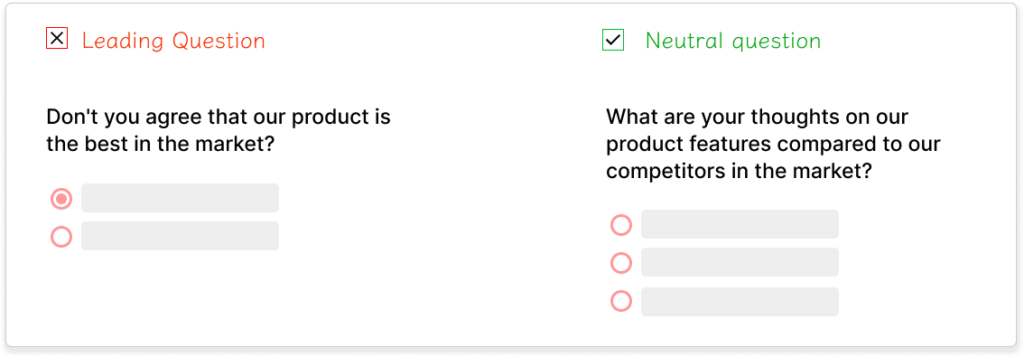
Keep the product survey questions simple
A well-designed survey should have simple and easy-to-understand questions. For example, for the English language, you should try to use a reading grade 4. After finalizing your questions, you should run them through some of your colleagues to see if the questions are simple and not confusing. You can also test the readability online.
Collect partial responses for longer surveys
A shorter survey can result in a better completion rate. However, in many cases, you need to design surveys that are longer to collect detailed feedback. When using a longer survey, you should make sure to collect the partial responses. When using a survey software like Affiniv, you can do this pretty easily. This makes sure that even if the user drops off without submitting the survey, the partial responses get captured. This helps with a better response rate.
Incentivize your users to get better response rate
Providing incentives to your users can be a good way to get a higher response rate. For example, e-commerce companies give out coupons for discounted shopping as a note of thanks. One way of incentivizing your users can be to offer Amazon or any other gift voucher.
Conclusion
Carefully selected product survey questions can give you much-needed insights to make your product better. It can also help measure customer satisfaction levels and help you design a product roadmap in consultation with your customers. Use some of the questions from this post and best practices to collect a higher number of quality responses.
A survey software like Affiniv can help you create a survey with various options. Plus you can distribute the survey easily using web/app embeds and email. You can create an account here; it’s free to get started.
Need an Affordable Survey Tool to create a Product Review Survey in Minutes?
Affiniv is the simplest way to measure customer metrics like NPS, CSAT and act upon your customer feedback.


